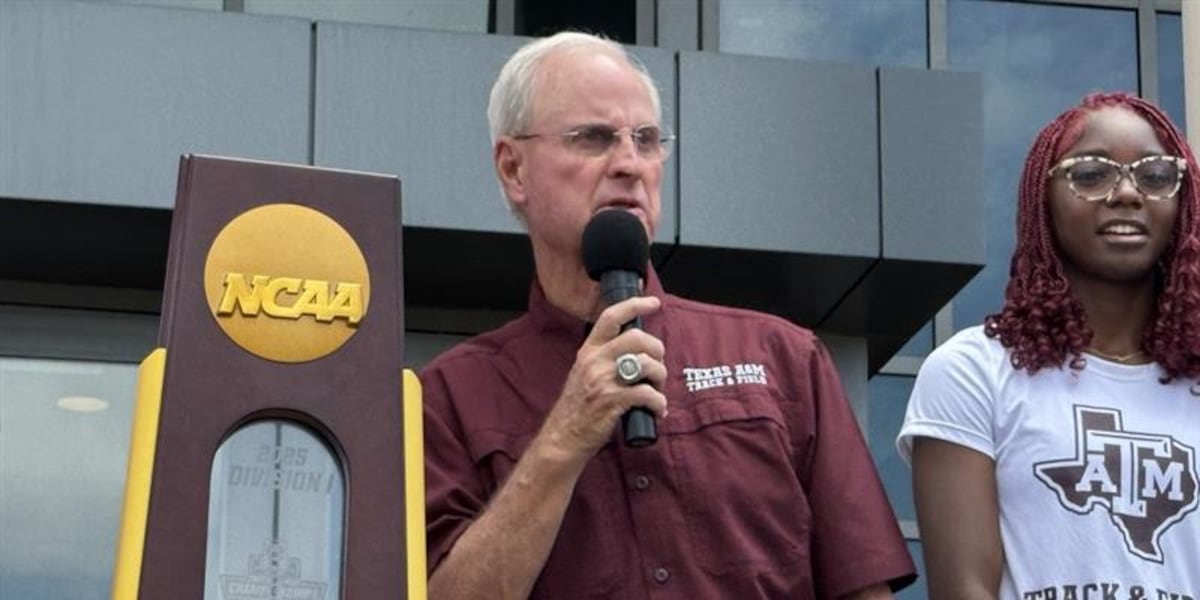
COLLEGE STATION, Texas (KBTX) – As Texas A&M track and field coach Pat Henry addressed 100-or-so fans that made their way to the front steps of E.B. Cushing Stadium, he held an air of confidence that only comes from winning 25 team outdoor national championships in his half-century at the helm.
Another NCAA Championship, this year from the men’s squad, wasn’t a surprise, but an expectation for his program.
And yet, with all of that experience in the sport, Henry said he was taken pleasantly by surprise when he heard how the House settlement would change his program.
As Henry builds his roster for a 2026 outdoor title defense, he will be able to offer scholarships to the full roster of men’s and women’s track athletes, both he and athletic director Trev Alberts confirmed with KBTX Monday.
“When I was told how the scholarships were going to work moving forward, it hit me too,” Henry told KBTX. “It’s kind of a shock and I’m excited about this opportunity.”
For A&M’s run to the men’s NCAA title, Henry had 12.6 scholarships to divide among 52 athletes. The women’s squad, who finished third at the NCAA Championship, had 18 scholarships divided among 55 athletes
For the 2023-24 athletic season, the most recent reported, A&M spent $632,601 for those 12.47 scholarships that were divided among 45 athletes, according to the school’s NCAA financial reporting documentation obtained by KBTX via open records request. For the women’s squad, the total was $894,136 for 17.46 scholarships divided among 41 athletes. Those figures also include indoor track and cross country.
Now, both men’s and women’s outdoor track will have 45 full or partial scholarships per program, which matches the new roster limit enforced by the House settlement.
Beyond the added scholarships the House settlement provides athletes in different programs, it also allows universities to enter into revenue sharing agreements. Trev Alberts previously stated that six programs at A&M will receive revenue sharing in the first year of the settlement term beginning July 1.
Track will not be one of those programs, Henry confirmed with KBTX.
Alberts has emphasized that revenue sharing will go to the six programs that can help grow revenue for the athletic department.
“What sports do you have additional seats? Where do you have attendance, right? Alberts said at the Southeastern Conference Spring Meetings in late May. “And so, you can sort of figure some of that out and the rest of our sports, you can look at scholarship increases, those type of things.”
It is assumed that some of A&M’s biggest revenue drivers will make up five of those revenue-sharing programs: football, men’s and women’s basketball, baseball and softball. Volleyball will be the last, a source with knowledge of the revenue sharing model confirmed with KBTX Monday. Soccer will not receive revenue sharing, but will have scholarships for its full roster of 28 athletes. For all programs, A&M will provide approximately 200 more scholarships for the 2025-26 year than the seasons prior, Alberts said at spring meetings.
The programs that receive revenue sharing can change year-to-year, Alberts confirmed Monday.
As of its last NCAA financial documentation for the 2023-24 season, football was the only Aggie program that produced a profit. Football led in revenue at $118.5 million, followed by men’s basketball ($12.2 million), baseball ($5.6 million), soccer ($2.6 million), volleyball ($1.2 million), women’s basketball ($1.2 million) and softball ($1 million).
Men’s and women’s tennis, as well as men’s and women’s golf produced the lowest profit deficit, followed by men’s basketball (-$2.1 million), men’s swimming (-$2.3 million), soccer (-$2.4 million) and volleyball (-$2.4 million). Softball’s deficit was -$3.3 million, followed by baseball (-$3.6 million) and women’s basketball (-$6.2 million).
Men’s and women’s track (which includes outdoor, indoor and cross country) were near the top in profit deficit at -$3.4 million and -$3.6 million, respectively, while pulling in $328,888 in revenue for the men and $343,726 for the women.
Henry said he understands the reality of how the revenue-sharing pie is cut, hoping that they can put more fans in seats in the coming years to make their case for a portion.
However, many schools around the country won’t have the money to provide scholarships for full rosters of Olympic sports, which can be as much of a competitive edge for those programs in recruiting as revenue sharing.
“We have an AD that wants to win in all sports and he’s going to give us that opportunity,” Henry said.
Copyright 2025 KBTX. All rights reserved.

Recent Comments